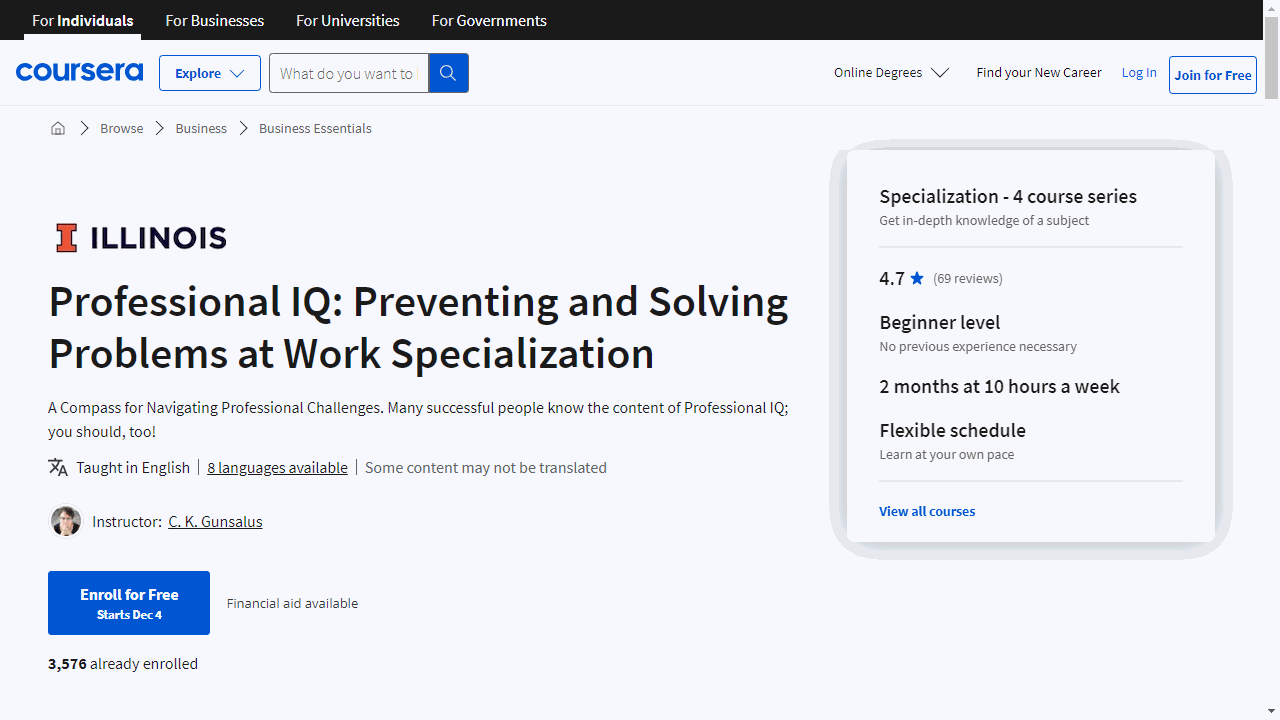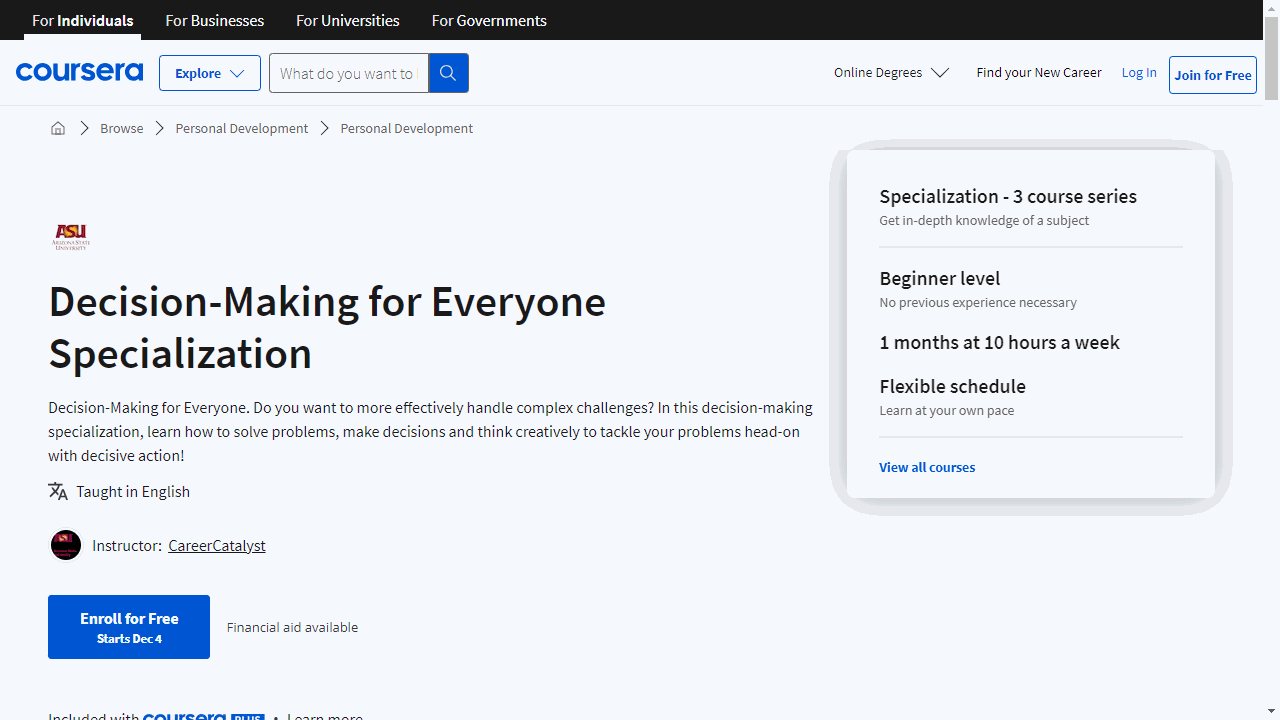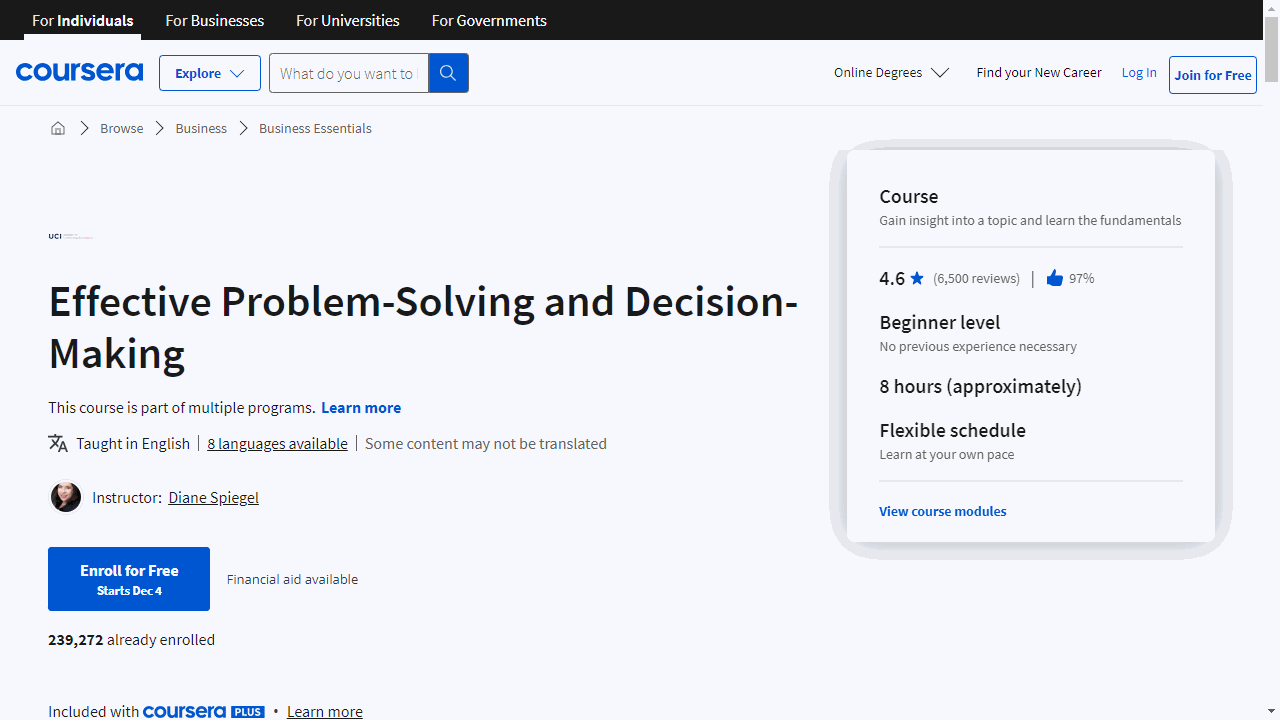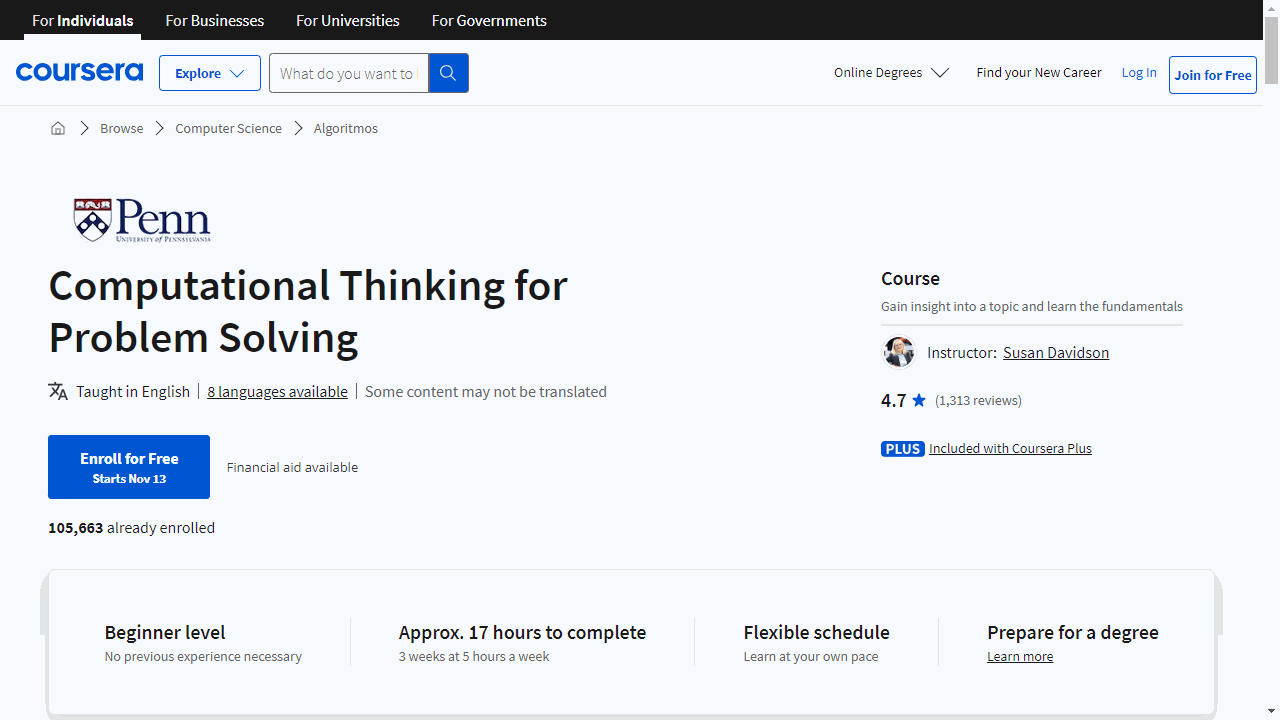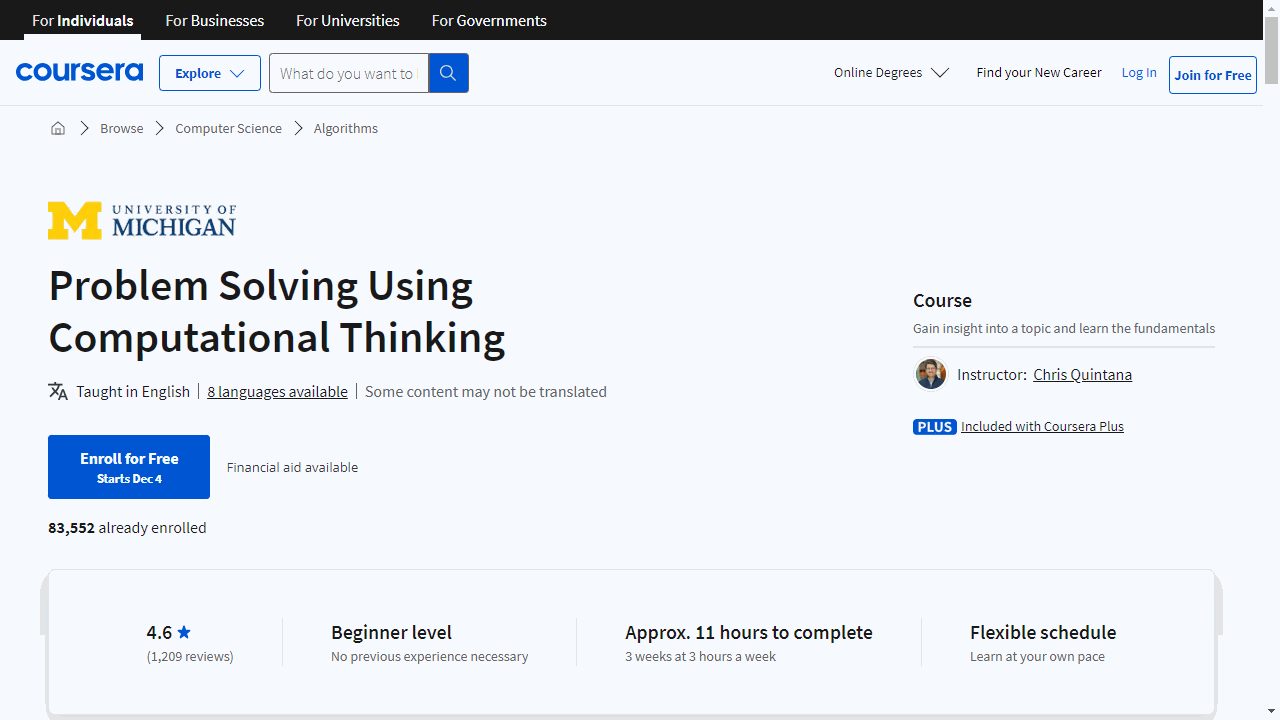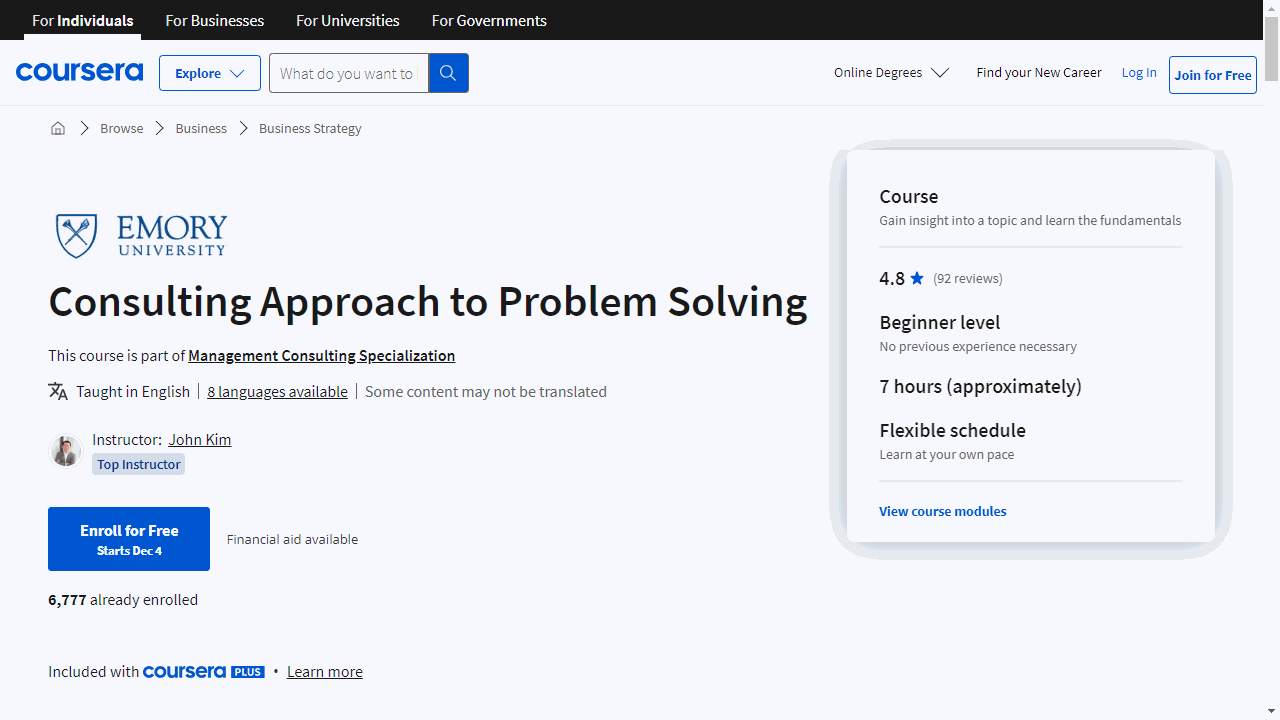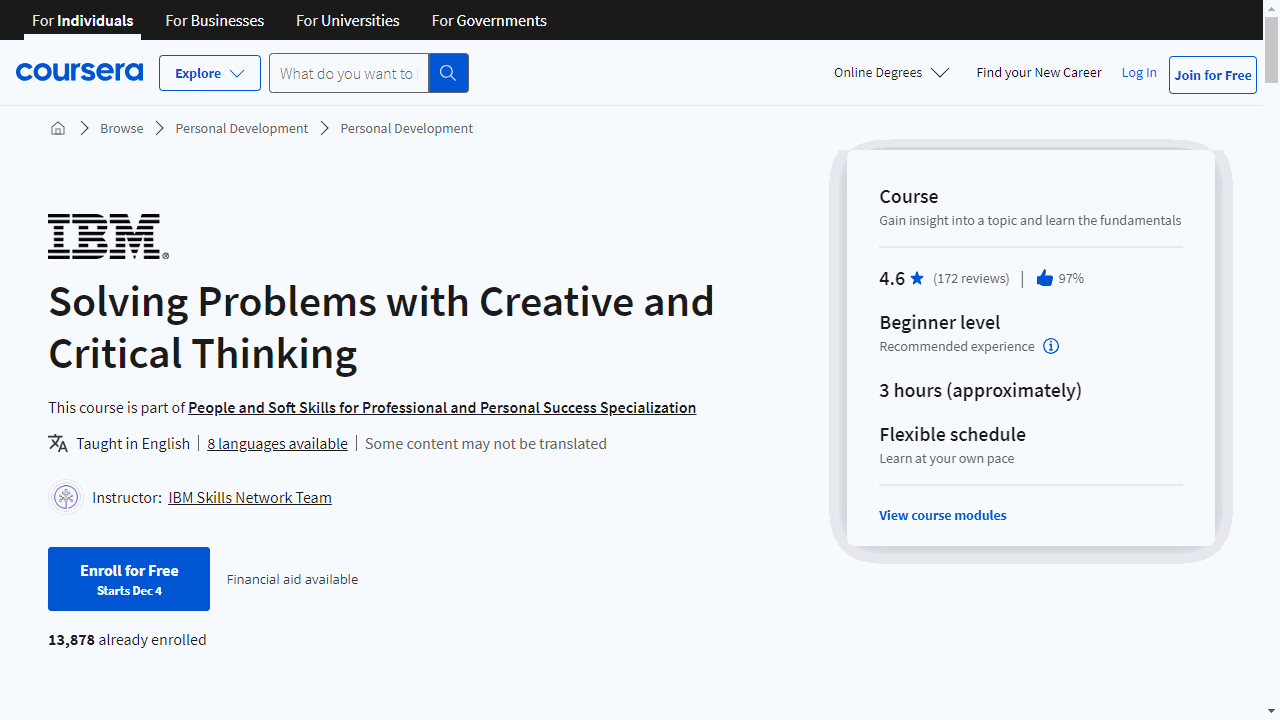Problem-solving is a fundamental skill that’s essential for success in any field.
It involves identifying issues, analyzing them, and coming up with creative and effective solutions.
Mastering problem-solving can empower you to overcome challenges, make better decisions, and thrive in a constantly evolving world.
Finding the right course to learn problem-solving can be overwhelming, especially with the vast number of options available online.
You want a course that’s engaging, comprehensive, and taught by experienced instructors.
For the best problem-solving course overall on Coursera, we recommend “Excel/VBA for Creative Problem Solving Specialization” by the University of Colorado Boulder.
This specialization teaches you how to use Excel and VBA to automate tasks, create custom functions, and tackle complex problems.
However, this is just one of many excellent problem-solving courses on Coursera.
Continue reading to explore additional options for beginners, intermediate learners, and experts, including courses focused on specific methodologies, industries, and domains.
Excel/VBA for Creative Problem Solving Specialization
This specialization from University of Colorado Boulder enhances your Excel capabilities by introducing you to the world of Visual Basic for Applications (VBA), a tool that can automate and customize your spreadsheets in ways you might not have imagined.
Starting with “Excel/VBA for Creative Problem Solving, Part 1,” you’ll learn to automate routine tasks by creating macros, which can save you a significant amount of time.
The course also covers how to craft user-defined functions, giving you the power to tailor Excel’s functionality to your specific needs.
VBA might seem daunting at first, but its intuitive nature makes it accessible even to those new to programming.
The course’s structure is practical, with each module presenting you with real-world inspired problems.
This approach ensures that the skills you acquire are not only theoretical but also applicable to everyday tasks.
The in-application assignments mean you’ll be practicing directly in Excel, reinforcing your learning through experience.
As you move on to “Excel/VBA for Creative Problem Solving, Part 2,” you’ll build on your foundation.
This course delves into more complex topics like managing arrays and text strings, and automating data consolidation from multiple sources.
You’ll also learn to create sophisticated user forms, which can elevate the way you interact with data and present your work.
Finally, “Excel/VBA for Creative Problem Solving, Part 3 (Projects)” offers a project-based learning experience where you can apply your skills to solve open-ended problems.
This course encourages creative thinking and problem-solving, and the peer review component provides valuable feedback and alternative perspectives on your approach.
Solving Complex Problems Specialization
This specialization offered by Macquarie University progressively builds your problem-solving prowess, offering practical tools and insights that you can apply directly to your career or industry.
“Analysing Complexity” is your starting point.
It equips you with the skills to identify underlying patterns in various problems, from physical to cultural systems.
You’ll learn why problems arise and how to confront contemporary challenges with a nuanced understanding.
In “Evaluating Problems,” you’ll delve into the mechanics of human thought and learn to navigate through cognitive biases.
This course offers a blend of philosophy, science, and statistics, providing you with a multidisciplinary approach to dissect and address problems from multiple angles.
“Creating Innovation” focuses on the essence of innovation and the conditions that foster breakthroughs.
You’ll explore the evolution of human creativity and how innovations can emerge from complex networks, preparing you to catalyze change in a market-driven environment.
The “Solving Complex Problems Capstone” is where you apply your learning to a real-world issue in your field.
This final project involves crafting a briefing paper that analyzes and proposes solutions to a complex problem, integrating the skills you’ve developed throughout the specialization.
Professional IQ: Preventing and Solving Problems at Work Specialization
This specialization offered by University of Illinois at Urbana-Champaign gives you a comprehensive set of strategies to address and prevent workplace issues.
Start with “Foundations of Professional Identity” to build a strong ethical base.
You’ll explore how to align your actions with your values and tackle ethical challenges without compromising your professional integrity.
This course is key to understanding the role of ethics in achieving success.
In “Shaping Your Professional Brand,” you’ll enhance your interpersonal skills.
Learn to listen actively, increase your likeability, and manage conflict.
This course prepares you to add value in your workplace and maintain professionalism, even when faced with difficult situations.
“Leadership and Influence” takes you to the next level, focusing on self-improvement as a catalyst for broader change.
You’ll gain skills in planning, negotiation, and conflict resolution, empowering you to articulate your vision, influence others, and shape a positive work environment.
The “Professional IQ Capstone” is the culmination of your learning journey.
Here, you’ll craft a Personal Leadership Credo, navigate a complex dilemma using decision-making frameworks, and develop a tailored leadership plan.
This capstone project solidifies your new skills and prepares you to apply them in real-world scenarios.
Business Problem Solving Specialization
This specialization is offered by Howard University.
Starting with “Fundamentals of Business Problem Solving,” this course is designed to sharpen your understanding of business processes.
You’ll learn to classify data effectively and build models to navigate complex business issues.
The course introduces you to Solver, a powerful Excel tool, enabling you to craft solutions and optimize business strategies.
By mastering spreadsheet manipulation and data interpretation, you’ll be equipped to analyze outcomes and inform decision-making.
Moving on to “Business Modeling Tools,” this course zeroes in on Excel’s Data Analysis toolkit.
You’ll delve into regression analysis, both single and multiple, to uncover patterns and predict trends.
This skill is crucial for constructing business cases and developing strategies that are informed by data.
Lastly, “Solving Business Problems with Spreadsheet Modeling” ties everything together with a practical capstone project.
Here, you’ll apply advanced data analysis techniques to real-world scenarios.
Learning to conduct Correlation and Sensitivity Analysis in Excel, you’ll gain insights into the relationships between variables and the impact of changes within your business model.
These courses stand out because they go beyond basic Excel training.
They equip you with analytical skills that are highly sought after in the business world.
Decision-Making for Everyone Specialization
This specialization is offered by Arizona State University.
Dive into the “Decision-Making” course to master the art of choosing wisely.
You’ll learn to navigate tough decisions with an ethical framework, assess risks effectively, and pinpoint the best course of action.
In the “Creative Thinking” course, you’ll unlock your creative potential.
Whether flying solo or collaborating, you’ll discover innovative approaches to problems that can set you apart.
The “Problem-Solving” course, led by Dr. Brent Scholar, transforms theory into action.
You’ll get to grips with collecting data and identifying underlying issues, applying these skills to real-world situations from day-to-day dilemmas to workplace conundrums.
Effective Problem-Solving and Decision-Making
This course from the University of California, Irvine enhances your ability to tackle complex issues and make well-informed decisions, skills that are essential in today’s dynamic work settings.
It begins by teaching you how to accurately identify problems, emphasizing the importance of looking beyond the obvious to uncover the real challenges.
You’ll learn to set clear parameters, which is especially useful in a hybrid work environment where remote and in-office dynamics can complicate issues.
As you progress, you’ll explore how to generate a variety of solutions by considering different team perspectives and recognizing your own biases.
The course stresses the value of diverse problem-solving styles and provides practical examples, particularly for hybrid work situations, to illustrate these concepts in action.
Decision-making is a critical focus of the course.
You’ll examine the impact of your choices and identify your decision-making style.
With this knowledge, you’ll practice selecting the best solution from the options you’ve generated.
Implementation and assessment are the final steps covered.
You’ll learn to measure the success of your solutions using data and assess their effectiveness in real-time.
This ensures that the problems you tackle are resolved efficiently and effectively.
Throughout the course, review sections help solidify your understanding and application of these skills.
Computational Thinking for Problem Solving
Offered by the University of Pennsylvania.
You’ll learn the art of decomposition, which is a fancy way of saying you’ll get really good at breaking big problems into smaller, more digestible parts.
It’s a skill that’s not just useful in computing, but in everyday life.
Pattern recognition comes next, teaching you to identify trends and sequences that can simplify problem-solving. Think of it as learning to spot the shortcuts in a maze.
Then, you’ll delve into data representation and abstraction, which is all about distilling information to its most basic form, making it easier to work with.
Algorithms are the heart of computer science, and you’ll explore how to create these step-by-step instructions to solve problems efficiently.
Real-world case studies will help you see these concepts in action, bridging the gap between theory and practice.
As you progress, you’ll tackle more specific challenges like finding the largest value in a set of numbers and mastering search techniques such as linear and binary search.
You’ll also explore algorithmic complexity, which is essentially learning how to measure the speed and efficiency of your solutions.
The course doesn’t shy away from more advanced topics either.
You’ll get acquainted with brute force and greedy algorithms, each offering a different strategy for problem-solving.
These concepts are not just theoretical; they’re practical tools that can be applied in various computing scenarios.
Taking a step back, the course provides a historical context with a brief history of computers and an introduction to the von Neumann Architecture, the foundational model for most modern computers.
Understanding this architecture is key to grasping how computers process and execute tasks.
Pseudocode will become your new language, allowing you to draft algorithms in a simplified manner that bridges human thought and computer action.
The final leg of the course introduces you to Python, a versatile and beginner-friendly programming language.
You’ll start with the basics like variables and conditional statements before moving on to lists, iteration, and functions.
By the time you reach classes and objects, you’ll be thinking and coding with the clarity and precision that Python enables.
Throughout the course, case studies serve as checkpoints, ensuring you can apply what you’ve learned to real-world problems.
By the conclusion, you’ll not only have a solid understanding of computational thinking but also hands-on experience with Python, setting you up for further exploration in the field of computer science.
Problem Solving Using Computational Thinking
This course is offered by University of Michigan.
It equips you with the skills to dissect complex issues into smaller, solvable parts.
You’ll start with the graphic organizer, a strategic tool that helps you plot your problem-solving path.
Think of it as your personal guide through the maze of challenges you’ll encounter.
The course takes you through the significance of computational thinking in image analysis, teaching you to create algorithms, which are step-by-step solutions, much like a recipe.
For those who crave a deeper dive, there’s an advanced video to satisfy your intellectual appetite.
Real-world applications are at the heart of this course.
Through case studies in airport security and epidemiology, you’ll apply computational thinking to pressing global concerns, checking your understanding at each step.
The curriculum also tackles the application of computational thinking to combat human trafficking, demonstrating the profound impact of your newfound skills.
Your learning culminates in a final project where you’ll identify a problem, plan your approach with the graphic organizer, justify your solution, and design an algorithm.
This project is your opportunity to apply your skills practically and creatively.
As you progress, you’re encouraged to share feedback and engage with the University of Michigan’s online learning community, further enriching your educational experience.
Consulting Approach to Problem Solving
This course from Emory University helps you dissect problems with a consultant’s precision, balancing a wide lens with targeted analysis.
You’ll have the option to network with peers during a meet and greet, and you can engage with fellow learners through active discussion forums.
These platforms are ideal for exchanging ideas and seeking guidance as you navigate the course material.
The curriculum kicks off with consulting essentials, arming you with strategies to sidestep scope creep—the tendency for projects to expand beyond their original boundaries.
You’ll master the art of categorizing issues into manageable “buckets” and linking them with “logic trees” for a structured problem-solving approach.
Hypothesis-based consulting is a focal point, teaching you to start with a tentative solution and rigorously test its validity.
This method bolsters your confidence in your recommendations and underscores the importance of data in substantiating your conclusions.
Data isn’t just numbers; it’s a goldmine of insights.
You’ll learn to embrace complex data sets, transforming them into compelling evidence to support your solutions.
The course also covers practical data management, including how to request, follow up, cleanse, and structure data effectively.
For those less familiar with Excel, resources like Exceljet.net are suggested to help you become proficient.
A highlight of the course is the DMAIC framework, a systematic approach to process improvement.
You’ll apply this tool to a practical scenario, such as weight loss, to cement your understanding.
As a final task, you’ll craft a one-page DMAIC example, showcasing your newfound skills.
Solving Problems with Creative and Critical Thinking
This course is offered by IBM.
You’ll start by understanding the importance of problem-solving and how to identify issues clearly.
Learning to write a problem statement is key, and you’ll practice crafting these to pinpoint exactly what needs fixing.
Determining the value of solving a problem is your next step.
Not every issue deserves your energy, so you’ll learn to focus on significant ones.
The course then guides you through analyzing problems using “The 5 Whys” to uncover the root cause.
With the problem laid bare, it’s time for solutions.
You’ll master brainstorming techniques and then use the Ease and Effectiveness matrix to choose the best option.
But it doesn’t stop there.
You’ll also discover how to measure the success of your solution and create an actionable plan to implement it.
Throughout the course, you’ll apply what you learn to a case study featuring Georgia’s dilemma, giving you real-world problem-solving experience.
By the end, you’ll have a robust five-step process for solving problems and the skills to apply creative and critical thinking effectively.
Also check our posts on:



